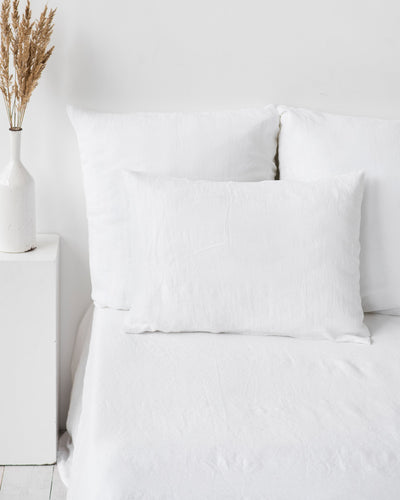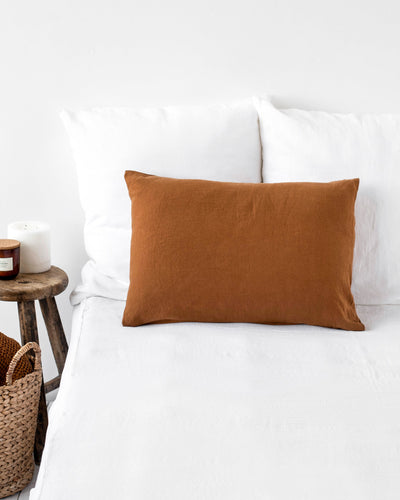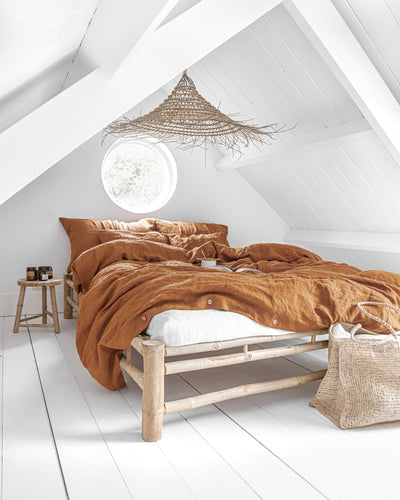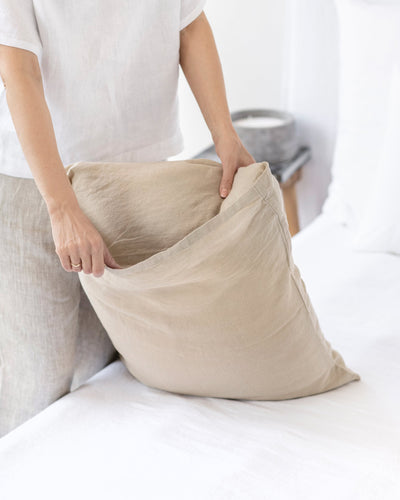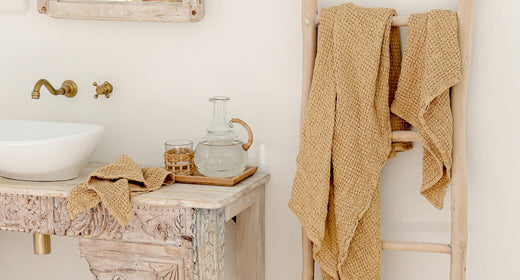Kids Linen Bedding: A Guide to Comfort and Style

More often than not, even if they feel it, children can't articulate their discomfort or understand what's wrong with their bedding. It's up to the parents and caregivers to be well-informed and choose suitable bedding for the kids while considering practical aspects like ease of washing and durability.
One of the best options on the market is kids' linen bedding. Known for its exceptional comfort, durability, and eco-friendly properties, linen bedding offers numerous benefits for children. Keep reading to better understand what makes this option an excellent choice, as well as how to clean and maintain linen kids' bedding.
Why Choose Kids Linen Bedding?
With so many options on the market regarding kids' bedding sets, it can be challenging to determine which material is best suited for your child's needs. Linen bedding has become increasingly popular among parents due to its numerous benefits, which we will explore below.
-
Comfort and softness
Linen is renowned for its exceptional comfort and softness, making it a perfect choice for kids' bedding. One of the standout features of linen is that it gets softer with each wash. Unlike some materials that deteriorate over time, linen improves in texture, becoming more comfortable and cozy. This evolving softness ensures that your child will always have a pleasant sleeping environment, which is crucial for a good night's rest.
Another significant advantage of linen is its breathability. Linen fibers are structured in a way that allows air to circulate freely, preventing the buildup of heat and moisture. This natural ventilation helps regulate your child's body temperature, keeping them cool in the summer and warm in the winter. The ability to maintain a consistent and comfortable temperature is essential for preventing night sweats and ensuring uninterrupted sleep.
You can easily pair linen bedding with a cozy baby blanket for extra warmth during cooler months. The added layer provides additional insulation, making it perfect for colder weather while maintaining a comfortable sleeping environment.

-
Durability and longevity
Children can be tough on their belongings, and bedding is no exception. Linen is naturally durable and can withstand the rough handling that often comes with kids' activities. The strong fibers of linen are resistant to wear and tear, making it an ideal material for long-lasting bedding.
Linen also has a high resistance to pilling and fading, which are common issues with other fabrics. Pilling occurs when fibers break and form small balls of fluff on the surface of the fabric, whereas fading results from repeated washing and exposure to sunlight. With linen, you don't have to worry about these problems. The material maintains its integrity and appearance over time, ensuring that your child's bedding stays looking fresh and new for years.
-
Hypoallergenic and safe
For children with sensitive skin or allergies, finding the right bedding can be a challenge. Linen's hypoallergenic properties make it an excellent choice for these situations. Linen is naturally resistant to dust mites and other common allergens, which helps reduce the risk of allergic reactions and skin irritations.
Additionally, linen has natural antibacterial and moisture-wicking properties. The fabric's ability to absorb moisture and release it quickly prevents the growth of bacteria and mold, creating a healthier sleeping environment for your child. This is particularly important for children who sweat at night or are prone to skin conditions, as linen helps keep their skin dry and irritation-free.
-
Eco-friendly choice
In an age where environmental sustainability is becoming increasingly important, choosing eco-friendly products for your home is a responsible decision. Linen is one of the most environmentally friendly textiles available. It is made from the flax plant, which requires minimal water and pesticides to grow, unlike other crops such as cotton.
The production process of linen is also relatively sustainable. Flax plants are used in their entirety, meaning there is little waste. Linen is biodegradable, so when it eventually does wear out, it won't contribute to landfill waste.
-
Aesthetic appeal
Beyond its practical benefits, linen also offers aesthetic advantages. Linen bedding has a timeless and versatile look that can enhance any bedroom decor. The fabric's natural texture and slight variations in weave give it a unique, rustic charm that is both elegant and casual.
Linen bedding comes in various colors and patterns, allowing you to find the perfect match for your child's room. Whether you prefer classic neutrals, vibrant hues, or playful prints, there's a linen option to suit every taste and style. This versatility makes it easy to update your child's bedroom as they grow and their preferences change without needing to replace the bedding.
Tips for Maintaining Kids Linen Bedding
While linen bedding is known for being low-maintenance, it still requires careful washing and storage to maintain its freshness and softness.
Washing and drying
Knowing how to wash linen is essential to ensure its durability. The process is simple and can be done both by hand or a washing machine.
If you're using a washing machine, it's important to separate linens by color and avoid mixing them with other clothes. Wash in lukewarm water (<40°C/104°F) using mild detergent and hang them up afterward.
To hand wash linen, fill a container with lukewarm water and mild detergent, soak the garments for 10 minutes, gently swish, and rinse until the soap is gone. Avoid wringing or twisting, then hang to dry.
Stain removal
Much like any other fabric, linen is not immune to stains. Though stained bedding is certainly frustrating, certain tips can help ease the cleaning process while keeping the fabric fresh.
To remove common stains from kids' bedding without damaging the fabric, follow these tips:
- Treat stains as soon as possible to prevent them from setting.
- Do not rub! Instead, gently blot the stain with a clean cloth to avoid spreading it.
- Use mild detergent
- Rinse the area with cold water to remove the remaining detergent.
- Avoid bleach as it can weaken fabrics and cause discoloration.
- Let the bedding air dry to prevent shrinking and fabric damage.
Storage

Storing your kids' linen bedding properly is also important to maintain its quality, freshness, and longevity. It will also reduce the likelihood of developing wrinkles or unpleasant odors.
To store linen bedding properly and keep it fresh, follow these tips:
- Make sure the linen is clean and completely dry to prevent mold and mildew.
- Fold the linen neatly to minimize wrinkles.
- Store the linen in a cotton or linen bag to allow airflow and keep it fresh.
- Avoid plastic bags, as plastic can trap moisture and cause mildew.
- Store the linen in a cool, dry area away from direct sunlight to prevent fading and damage.
- Place lavender or cedar sachets with the linen to maintain a pleasant scent.
Conclusion
Choosing kids' linen bedding is an investment in your child's comfort, health, and the environment. Its softness, durability, hypoallergenic properties, and eco-friendliness make it an excellent choice for parents seeking high-quality bedding. Additionally, the timeless aesthetic of linen adds a touch of elegance to any bedroom decor.
By opting for linen, you're ensuring that your child enjoys a cozy, safe, and stylish sleeping environment. Plus, as every parent knows, better sleep for your child means better sleep for you, too.
Frequently Asked Questions (FAQs)
Are linen sheets good for kids?
Yes, linen sheets are excellent for kids due to their natural softness, breathability, and hypoallergenic properties, providing a comfortable and healthy sleeping environment. Additionally, their durability makes them a practical choice for active children.
Is linen bedding really worth it?
Linen bedding is worth the investment because it becomes softer over time, lasts longer than many other fabrics, and offers numerous health benefits, including temperature regulation and moisture-wicking. Its eco-friendly production process also makes it a sustainable choice.
What age can a child use a duvet?
Most children can start using a duvet around the age of 18 months to 2 years once they transition from a crib to a toddler bed. It's important to choose a lightweight duvet suitable for their age to ensure safety and comfort.
 United States
United States
